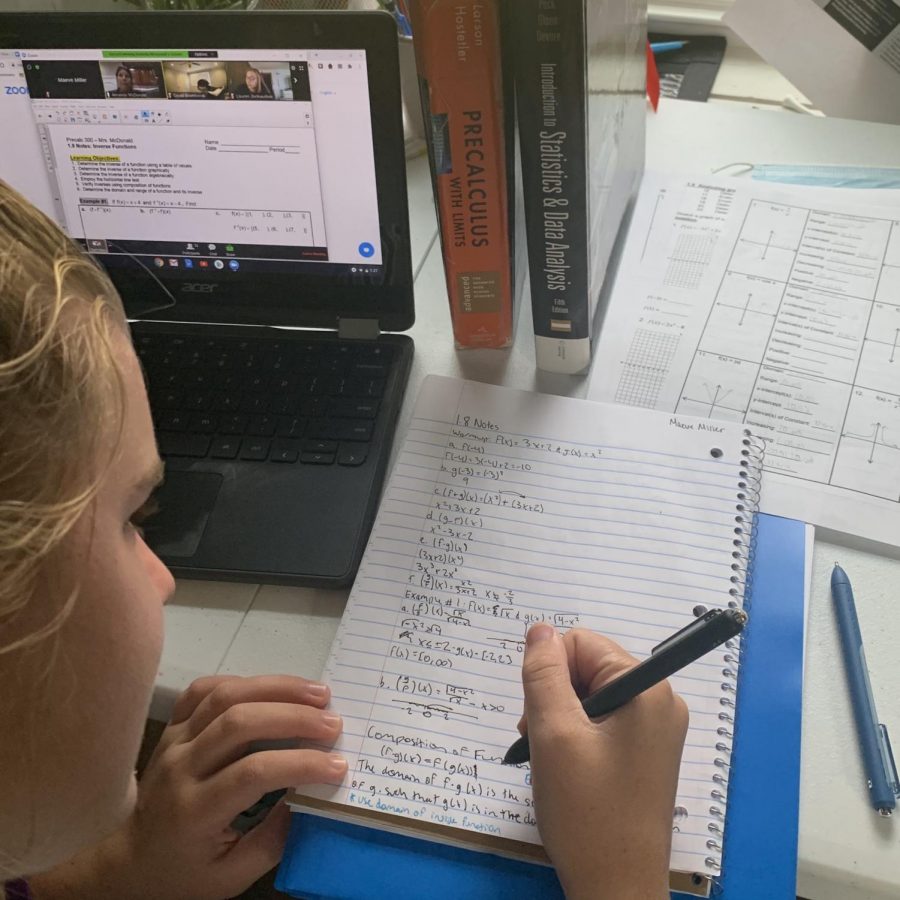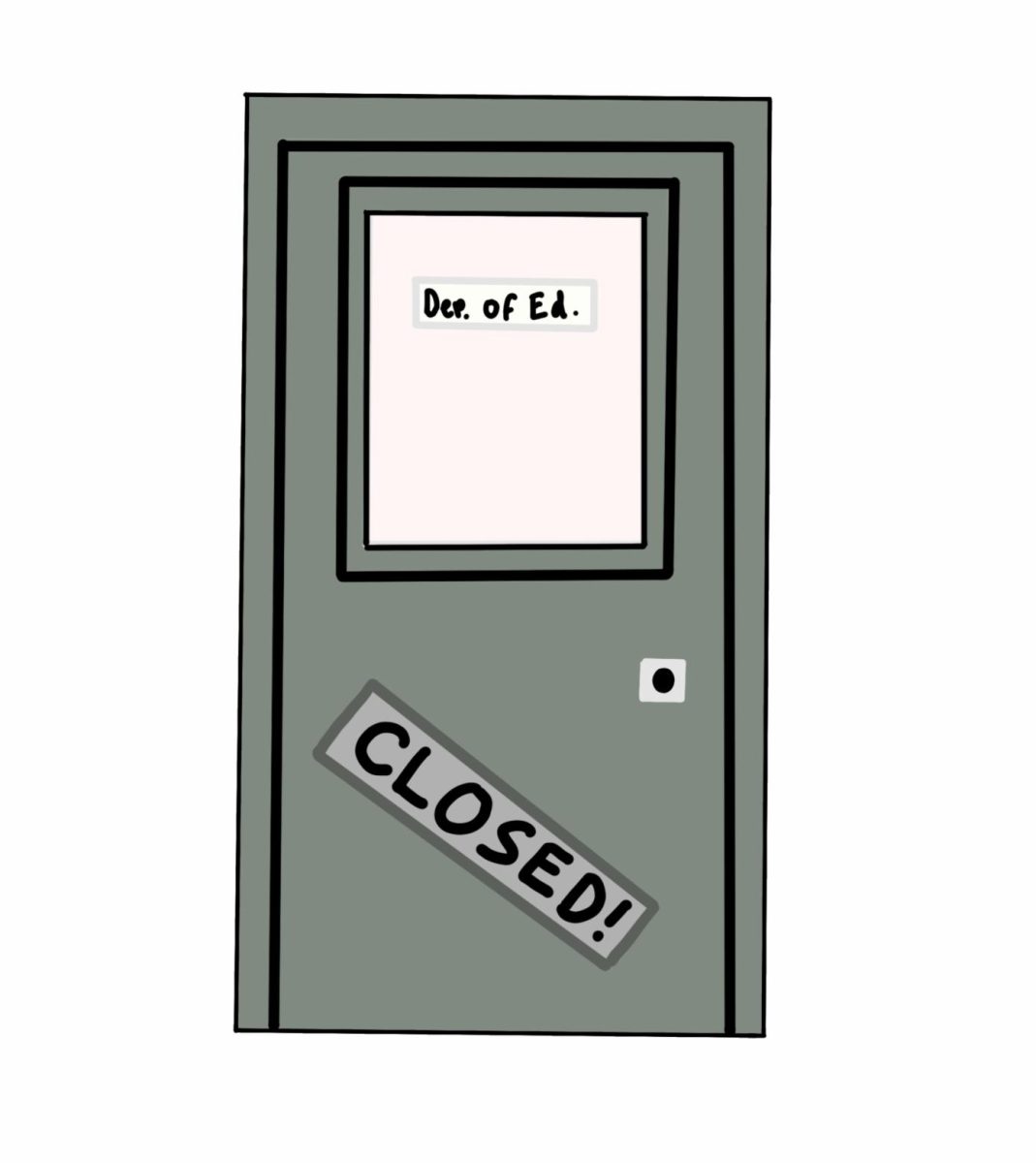Overcoming Online: Math department tries to solve their own set of “real world” problems
TAKE NOTES: Junior Maeve Miller copies down problems during her Precalculus Zoom class.
September 16, 2020
To most students, whether honors or regular, math has always had its challenges. Now, with the addition of remote learning, the struggles for most teachers and students have grown exponentially.
Math teachers are used to peering over students’ shoulders and noticing facial expressions to know what’s troubling students, but they can’t do that through the screen. With the first month of e-learning finished, the math department still faces difficulties regarding curriculum, learning tools, and teacher-student relationships.
TEACHERS COPING WITH ONLINE
Math department chair Jon Heldmann describes the struggles of remote learning from a teacher’s perspective.
“[In the classroom] we can see the work you’re doing and read body language to tell if you’re stuck. We can’t read any of that if kids have their camera off, we can only see the top of your head, or even if we can see your whole face but you’re never saying anything in a Zoom meeting,” Heldmann said.
Heldmann teaches Prep for Quantitative Literacy, a math course designed for college-bound students who do not wish to take an AP class. He encourages his co-workers to recognize the need to be flexible with their online students as they adapt to their new learning environment.
“[The math department] is trying to take it week by week and make decisions based on how kids are doing and how we can adjust to technology issues. I am trying not to assume that because they aren’t in class means they don’t want to be in class,” Heldmann said.
Although teachers are trying to be more flexible, maintaining a school-like atmosphere is proving to be difficult.
“So many teachers that I know of are just really struggling with the fact that we can’t get to know the activity you like best or what you do after school,” Heldmann said. “We are trying to use breakout rooms, small groups, and help out in that regard because it’s not just about the course, it’s about [the students].”
CURRICULUM CONCERNS
The curriculum is another main obstacle that the department faces. Due to last spring’s remote learning, many math students were unable to learn a full year’s worth of content. In turn, that made them unprepared for their math class this year.
Junior Maeve Miller is enrolled in both Precalculus and AP Statistics this year and feels as though she has to work harder to make up for lost time.
“AP Stats is more challenging because we didn’t get to learn about stats last year at the end of Math 3. So, it’s a whole new course dedicated to things I didn’t get to learn last year,” Miller said.
There is no doubt that students will be learning less content than years prior because of less time in each class. In a normal setting, they would have 250 minutes per week in each class. In remote learning, they only have 185 minutes. With that time constraint, math is particularly difficult because of how it builds from year to year. The domino effect will continue as students fall behind on certain skills.
“The biggest challenge is trying to continue to teach new lessons while also trying to be as slow as possible to make sure kids don’t get behind within the first couple weeks of school, Heldmann said. “If we don’t try to keep moving into new lessons, we are going to be so far behind as we move into October and November, that it’s going to be really tough to catch up.”
CHANGE OF PACE
Although teachers may feel as if their pace is dangerously slowing down, students on the other side of the screen feel differently.
“It would be easier if [the lesson] was just a video because it’s not like [the teacher] stops anyway. He could totally get it done in a video, where I could pause it when I needed to,” junior Precalculus student Emily Adamo said.
The pace in the classroom is a balancing act between preparing students for a higher level and making sure they fully understand the concepts. Along with the teachers learning to adapt, the students are expected to meet them halfway.
“I’ve had to look up concepts on Khan Academy and I try to take better notes because I feel like I don’t have enough time. Especially for Precalc; we go through multiple lessons a day,” Miller said.
READY FOR CHANGE
It’s no secret that online comes with its fair share of challenges, but the math department continues to adapt in order to help their students prepare for the next step.
“Even if it’s back to normal in the second semester or next year, this is going to take years to adjust to. We are aware of that, we have a plan in place for that,” Heldmann said. “It’s not going to be perfect but we are being proactive in that regard.”

























